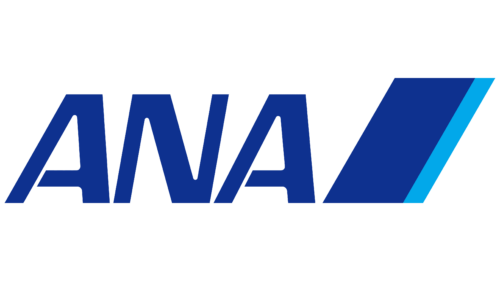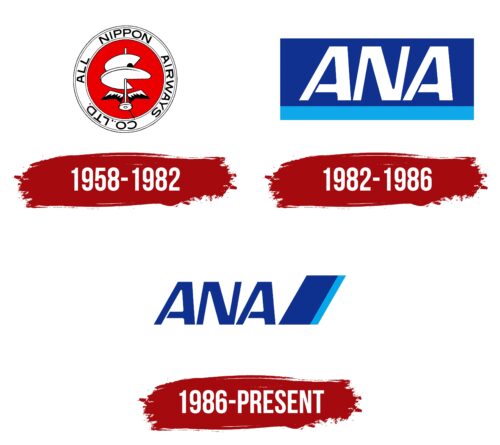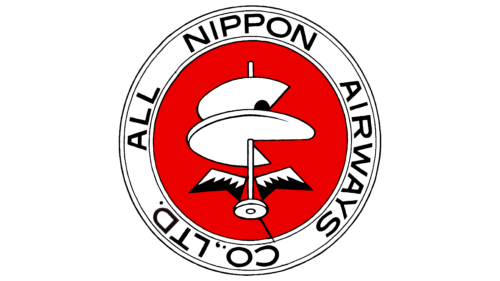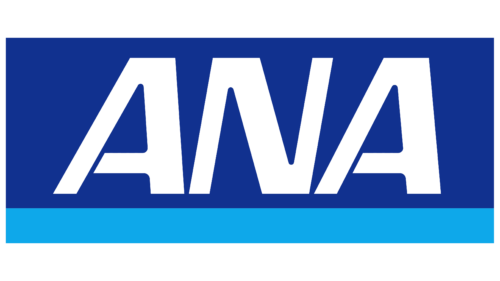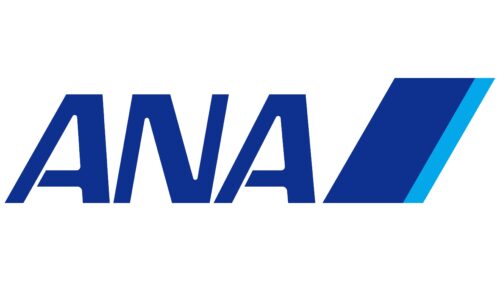The All Nippon Airways (ANA) logo, featuring a two-level emblem, showcases the airline’s commitment to innovation, cultural heritage, and technological excellence. This emblem reflects company leadership and dedication to safety in aviation, using a color scheme that symbolizes the airline’s esteemed reputation within the global aviation community.
All Nippon Airways: Brand Overview
All Nippon Airways’ history started in 1952 when the Japan Helicopter and Aeroplane Transport Company (日本ヘリコプター輸送) was founded. A group of Japanese investors led by Hidemaro Nagata created this modest business. As suggested by its initial name, the company’s primary focus was helicopter transportation. The post-World War II limitations on employing aircraft for civil aviation in Japan were the reason for this focus.
The firm carried out its maiden commercial flight on December 27, 1953, a helicopter cargo voyage from Tokyo to Osaka. This flight was a pivotal moment in the growth of post-war civil aviation in Japan and the start of the company’s activities.
In 1954, the business renamed itself All Nippon Airways (ANA) (全日本空輸株式会社). This modification represented the company’s growing goals and intention to join the fixed-wing aircraft industry. The same year, the company was authorized to conduct domestic passenger flights.
The airline flew a de Havilland Dove on its inaugural routine passenger trip between Tokyo and Osaka on February 1, 1955. This flight quickly expanded the firm’s network throughout Japan.
The 1960s saw the company go through a period of explosive expansion. The business aggressively developed its route network, linking Japan’s major cities. The Vickers Viscount, the company’s first turboprop aircraft, was introduced in 1961, enhancing the comfort and speed of its services.
The company accomplished a noteworthy feat 1964 when it purchased its first jet aircraft, a Boeing 727. This created the foundation for the company’s upcoming international expansion while greatly enhancing its capabilities on important domestic routes.
The airline started offering charter flights to Hong Kong in 1965, marking its entry into the global market and the beginning of its long-term plan to increase its market share outside of Japan.
The company kept updating its fleet during the 1970s. The Lockheed L-1011 TriStar, the company’s first wide-body aircraft, was delivered in 1970. Because of this, the airline was able to boost passenger volume and enhance operational effectiveness on well-traveled routes.
When the airline started operating regular overseas flights in 1978, Guam was the first foreign destination. This allowed the business to compete globally and launched a new chapter in its history.
The company kept growing its network of international routes during the 1980s. In 1986, the airline began operating flights to the United States, with the Tokyo-Washington route being the first. During this time, the company invested significantly in cutting-edge technology, such as computerized reservation systems.
The company underwent complete privatization in 1986. As a result, it could make more decisions with greater flexibility and compete in the global market.
The airline continued growing its global network throughout the 1990s, adding new flights to Asia and Europe. In 1991, the company’s first Boeing 747-400 arrived, improving its ability to manage long-haul trips.
In 1999, the company became a founding member of the international airline association Star Alliance. This improved the company’s standing in the global market and greatly increased its capacity to provide services to travelers worldwide.
In the 2000s, the airline continued modernizing its fleet and improving service quality. In 2004, the business introduced ANA Wings, a low-cost brand catering to regional routes.
2011, the company became the first customer to fly the ground-breaking Boeing 787 Dreamliner. Receiving the first commercial 787 in history demonstrated its dedication to innovation and leadership in the sector.
Between 2012 and 2015, the airline increased its global footprint by adding new routes and boosting flight frequency on already-existing ones. In addition to these investments, the business upgraded airplane cabins and launched new passenger services.
From 2016 to 2019, the company maintained its expansion plan. For well-traveled tourist routes, the business placed orders for new aircraft, notably the Airbus A380. The company increased its market share in Southeast Asia by investing in regional airlines.
As part of its fleet renewal strategy, the airline received its first Airbus A380 in 2020, which was put into service on the well-traveled Tokyo-Honolulu route. This change enabled the company to provide travelers on this popular route with a new degree of comfort.
The company revealed plans to restructure that same year to increase operational effectiveness. The business disclosed plans to combine its current low-cost brands, Peach and Vanilla Air, into a new budget division.
In 2021, the airline prioritized innovation and sustainable development. The company showed its commitment to environmental responsibility by announcing plans to use sustainable aviation fuel (SAF) on some of its flights.
In October 2021, the airline carried out an unmanned aerial vehicle (UAV) test flight to transport supplies to isolated islands in Japan. This demonstrated the company’s commitment to embracing new technology and expanding the scope of its services.
The company’s New Boeing 787 Dreamliners, received in 2022, helped to modernize its fleet further and improve its performance on foreign routes. In response to the rising demand for air freight, the airline announced intentions to extend its cargo fleet that year, further solidifying its position in the cargo sector.
Additionally, the company’s Mileage Club, its reward program, was upgraded and now offers travelers more ways to accrue and use miles.
In 2023, the company continued investing to raise the caliber of passenger service. The airline debuted an updated interior layout for its lengthy-haul fleet, with new business-class seats and enhanced entertainment systems.
The airline revealed a new set of carbon emission reduction targets as part of its sustainability plan. The business adopted more effective operating practices and used more sustainable aviation fuel.
Additionally, the airline increased its collaboration with Star Alliance, resulting in better connections and more practical itineraries for travelers passing through Tokyo.
Meaning and History
What is All Nippon Airways?
It is a major Japanese airline headquartered in Tokyo. It operates an extensive network of domestic and international flights, connecting Japan to destinations in Asia, Europe, North America, and Oceania. Known for its high service and safety standards, it offers various service classes, including economy, premium economy, business class, and first class. The airline is a member of Star Alliance and supports the country’s tourism and economic growth.
1958 – 1982
All Nippon Airways, recognized by this name from 1958 to 1982, began with a unique logo that symbolized its aviation heritage. The first logo featured a round emblem centered around an image of a rotating propeller. This symbol was chosen to reflect the company’s aviation origins, tracing back to its days as Nippon Helicopter, a precursor to All Nippon Airways. The propeller in the logo symbolizes innovation and advanced technology in aviation.
Leonardo da Vinci’s propeller sketches inspired this concept in the 15th century. Da Vinci envisioned mechanisms similar to helicopter propellers and conceptualized vertical takeoff and landing—a groundbreaking notion for his era. Including such a symbol in the logo emphasized ANA’s dedication to innovation and reverence for historic aviation milestones.
The logo’s red and white color scheme was chosen intentionally. These are Japan’s national colors, representing deep respect and honor for the country. The use of these national colors underscored the company’s dedication to Japanese traditions and culture.
The company name encircles the round emblem, signaling its youthful spirit and ambitious nature. All Nippon Airways was formed through the merger of Far East Airlines and Nippon Helicopter, aiming to establish a prominent national carrier capable of competing internationally and offering extensive passenger and cargo services.
1982 – 1986
The new emblem for All Nippon Airways was introduced to highlight the airline’s route network expansion and strategic company changes. Inspired by elements of the flag, the design symbolizes new horizons and opportunities. The emblem features the blue sky, reflecting the essential element of aviation, and includes a blue stripe representing the ocean. This design marks a new era for the airline as All Nippon Airways expands its routes to encompass all the country’s islands and offers flights over bodies of water.
The logo displays three white letters, “ANA,” against a sky-like background, which adds a visual sense of lightness and space. These letters stand for the company’s full name, All Nippon Airways, and are part of the codes used by the International Air Transport Association (IATA). This abbreviation is recognized in the aviation industry and is associated with flights and airlines, highlighting ANA’s membership in the global aviation community.
1986 – today
The new emblem for All Nippon Airways features a blue and light blue color scheme transformed into an image resembling a dynamic wing or a road ascending into the sky. This design marks the beginning of a new era in the company’s history, as it has been granted the right to operate international flights. The logo’s design conveys freedom and possibilities through new international routes.
The company’s name, previously in white, is now presented in blue, blending seamlessly with the logo’s color scheme. This adjustment enhances the design’s coherence and emphasizes the brand’s alignment with its refreshed mission and vision. ANA’s visual identity now symbolizes its commitment to growth and exploration of new horizons, reinforced by the authorization for international operations.
The imagery of a wing or road leading into the sky symbolizes the company’s forward movement toward new objectives and challenges. With its rich history and proven success, ANA is now advancing to a new stage in international operations. This initiative reflects its dedication to expanding its flight network and continuing to offer high-quality service to its passengers, wherever their destinations may be.
FAQ
What is the meaning of all Nippon?
“All Nippon” in “All Nippon Airways” (ANA) means “All Japan” or “Entire Japan.” “Nippon” is a native Japanese name for Japan, used in formal situations. Another common name for Japan in Japanese is “Nihon.”
The name “All Nippon” shows the airline’s goal to be a comprehensive carrier connecting all parts of Japan. When the company changed its name from Japan Helicopter Transport to All Nippon Airways in 1957, it wanted to expand. It started with helicopters and then added planes, aiming to cover the whole country. This change helped it become a major domestic and international airline.
Which airline code is ANA?
The airline code for All Nippon Airways Co., Ltd. is “NH.” Assigned by the International Air Transport Association (IATA), this two-letter code uniquely identifies airlines globally. It is used in flight scheduling, ticketing, and baggage handling to help maintain consistency and efficiency across international aviation systems. This code simplifies communication and operations at airports and with other airlines worldwide.
Is NH All Nippon Airways?
NH is the airline code for All Nippon Airways (ANA), one of Japan’s largest companies. Based in Tokyo, the company flies to about 50 destinations within Japan and another 32 internationally across Asia, Europe, and North America. The company covers major cities and smaller regions, meeting various travel needs for both business and leisure.
Is All Nippon Airways 5-star?
Yes, All Nippon Airways (ANA) is a 5-star airline. It has kept this top rating since 2013, for 11 years in a row, which makes it the only Japanese airline to do so for such a long time. This shows the company’s ongoing commitment to excellent service and the outstanding hospitality of its employees every day. The 5-star rating marks high quality in customer service, onboard amenities, and overall passenger experience.
